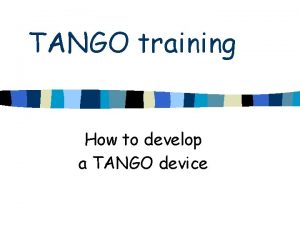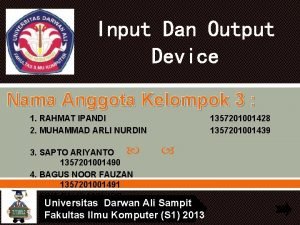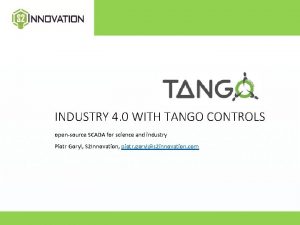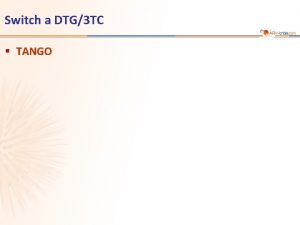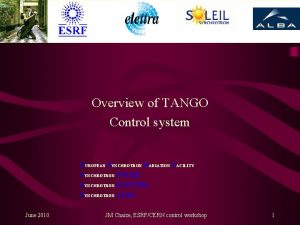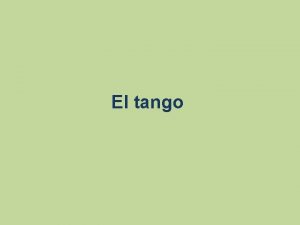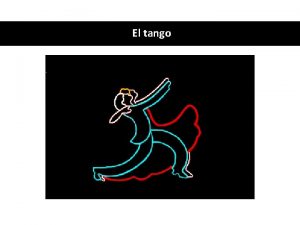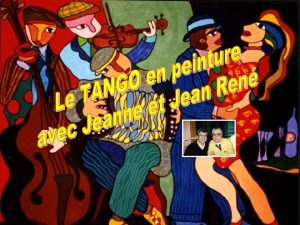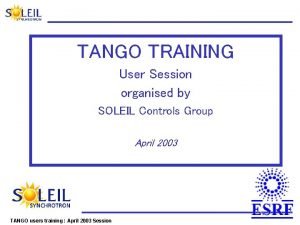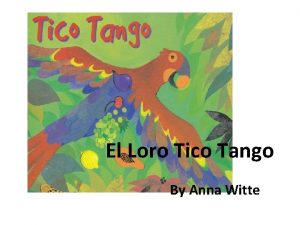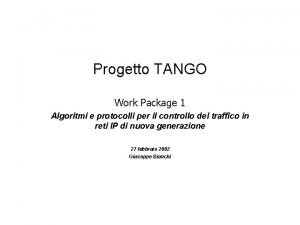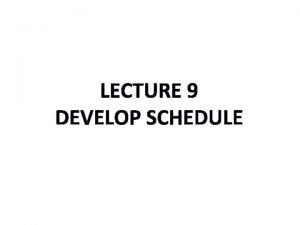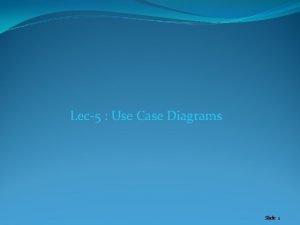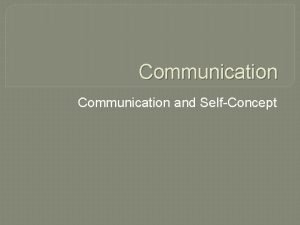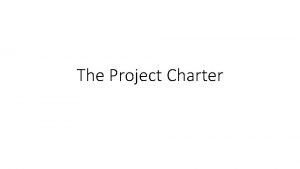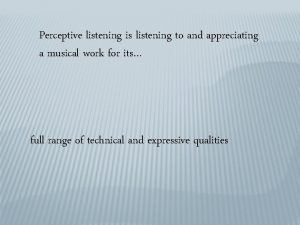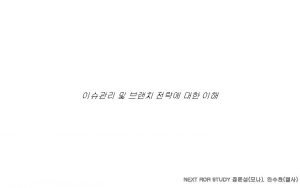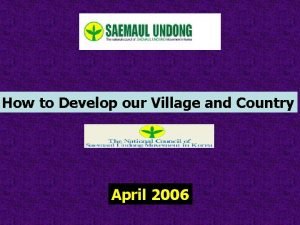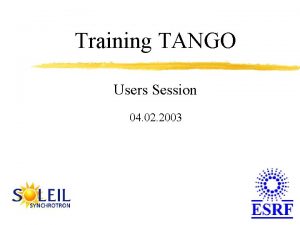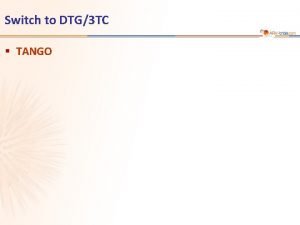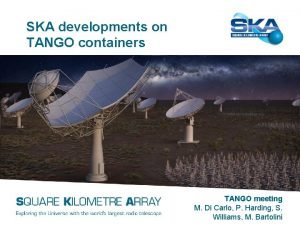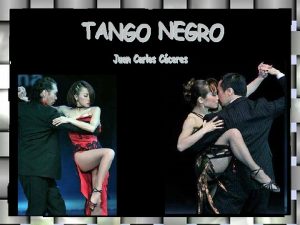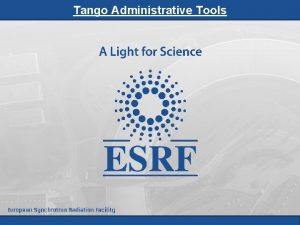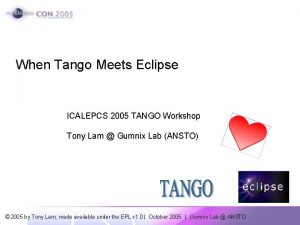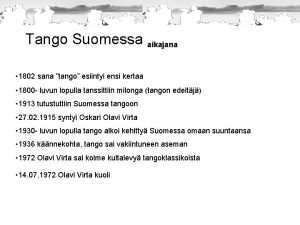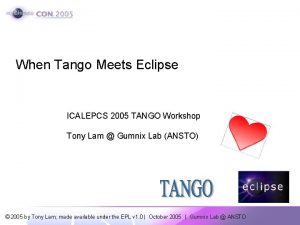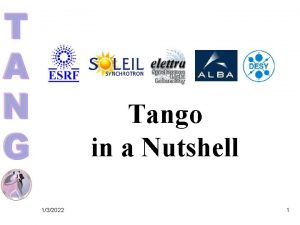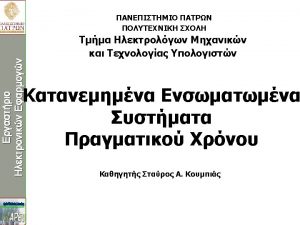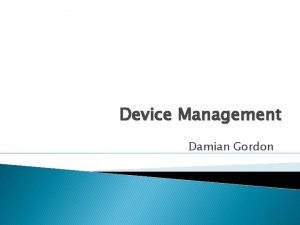TANGO training How to develop a TANGO device





















![E 4 : Execution n Syntax – {EXEC NAME} {INSTANCE NAME} [-v{VERBOSE LEVEL}] • E 4 : Execution n Syntax – {EXEC NAME} {INSTANCE NAME} [-v{VERBOSE LEVEL}] •](https://slidetodoc.com/presentation_image/3bd2bbc35769c7a1c5bc03fed0ade6d9/image-22.jpg)
![E 4 : Execution n Syntax – {EXEC NAME} {INSTANCE NAME} [-v {VERBOSE LEVEL}] E 4 : Execution n Syntax – {EXEC NAME} {INSTANCE NAME} [-v {VERBOSE LEVEL}]](https://slidetodoc.com/presentation_image/3bd2bbc35769c7a1c5bc03fed0ade6d9/image-23.jpg)




























- Slides: 51

TANGO training How to develop a TANGO device

Preamble n Ambition – Approaching different steps of a device development – Handling the tools n Collective approach n Individual approach – Operating concepts of session I – A C++ example – Read the documentation ! • Tutorial C++ & Java • Many implementation details

The example n Servers… – device Beam. Image • Beam image (made in the plan of 1 screen) • Supposed to be linked to a camera (with on/off ctrl ) • Params : size (pixels) , scaling (mm/pixel) – device Beam. Dim • • n Profiles and size of beam Logical device (SC service) Analysis of the image produced by Beam. Image Params : image source (device) The client(s)… – Matlab and/or Igor Pro and/or Device. Tree

E 1 : Definition of interfaces n Preliminary essential step – Led by the clients’ need – Functionalities and/or datas to «export» ? n Contract with the clients – Attractive choice – Strong link with non generic clients n Elementary choices – Commands, Attributes, Ownerships – Command or Attribute ? • command ~ action • attribute ~ physical size «monitorable»

E 1 : Beam. Image : interface – – – Commands void Set. Image. Size(long) long Get. Image. Size(void) void Set. Image. Scaling(double) double Get. Image. Scaling(void) void Switch. On (void) void Switch. Off (void) size pixels (size * scaling) mm n 6 (size * scaling) mm

E 1 : Beam. Image : interface n 3 Attributes size pixels (size * scaling) mm – size • WRITE, SCALAR, LONG – scaling • READ_WRITE, SCALAR, DOUBLE – bimage • READ, IMAGE, LONG (size * scaling) mm

E 1 : Beam. Image : interface n 2 States – ON • Camera ON • All commands authorized except Switch. On • Reading image authorized – OFF • Camera OFF • No authorized command except Switch. On • Reading image forbidden – TANGO • State management -> command execution • No state management -> reading/writing attribute

E 1 : Beam. Dim : interface n 2 Commands • string Get. Image. Source(void) • void Set. Image. Source(string)

E 1 : Beam. Dim : interface n 4 Attributes – x_profil & y_profil • READ, SPECTRUM, LONG – x_dim & y_dim • READ, SCALAR, DOUBLE x_profil x_dim

E 2 : Code generation n POGO – The Program Obviously used to Generate Tango Objects – Java Application • Win 32, Linux, Sun-Solaris – Code generator • C++ or Java – Devices skeleton • Commands, Attributes, Ownerships, States – To launch POGO under Windows… • %SOLEIL_ROOT%tangowin 32scriptstart-pogo. bat

E 2 : POGO : Prog. Language

E 2 : POGO : New Project

E 2 : POGO : New Project Classe du device

E 2 : POGO : New Project

E 2 : POGO : States class Beam. Image interface : états -ON : Camera on -OFF : Camera off

E 2 : POGO : Commands class Beam. Image interface : commands Tango: : DEV_VOID Set. Image. Size(Tango: : DEV_LONG) - allowed for states: ON Tango: : DEV_LONG Get. Image. Size(Tango: : DEV_VOID) - allowed for states: ON Tango: : DEV_VOID Set. Image. Scaling(Tango: : DEV_DOUBLE) - allowed for states: ON, OFF Tango: : DEV_DOUBLE Get. Image. Scaling(Tango: : DEV_VOID) - allowed for states: ON, OFF Tango: : DEV_VOID Switch. On(Tango: : DEV_VOID) – allowed for states: OFF Tango: : DEV_VOID Switch. Off(Tango: : DEV_VOID) – allowed for states: ON

E 2 : POGO : Attributes class Beam. Image interface : attributes –size • WRITE, SCALAR, LONG • Val_Min = 100, Val_Max = 500, Unit = pixels • Write allowed for states : ON –scaling • READ_WRITE, SCALAR, DOUBLE • Val_Min = 0. 001, Val_Max = 10, Unit = mm/pixel • Read/Write allowed for states : ON, OFF –image • READ, IMAGE, LONG • Read allowed for states : ON

E 2 : POGO : Code generation

E 2 : POGO : Doc generation

E 3 : Compilation n Creating the working environment – Positioning the variables of environnement • %SOLEIL_ROOT%envwin 32env. SOLEIL. bat • executing this script in a console – Copying and modifying the Makefile • %SOLEIL_ROOT%envwin 32Makefile. VC • copying to the directory of the device • editing : device_server = Beam. Image n Compiler – nmake –f Make. File. VC all – nmake –f Make. File. VC clean

E 3 : Compilation n Where is the result of the compilation ? – Intermediate files • C: TEMP{USER NAME}{DEVICE NAME} – Executable • C: Device. Serversds_{DEVICE NAME}. exe
![E 4 Execution n Syntax EXEC NAME INSTANCE NAME vVERBOSE LEVEL E 4 : Execution n Syntax – {EXEC NAME} {INSTANCE NAME} [-v{VERBOSE LEVEL}] •](https://slidetodoc.com/presentation_image/3bd2bbc35769c7a1c5bc03fed0ade6d9/image-22.jpg)
E 4 : Execution n Syntax – {EXEC NAME} {INSTANCE NAME} [-v{VERBOSE LEVEL}] • {EXEC NAME} = name of the binary • {INSTANCE NAME} = name of the device instance – C: Device. Serversds_Beam. Image 1 –v 4
![E 4 Execution n Syntax EXEC NAME INSTANCE NAME v VERBOSE LEVEL E 4 : Execution n Syntax – {EXEC NAME} {INSTANCE NAME} [-v {VERBOSE LEVEL}]](https://slidetodoc.com/presentation_image/3bd2bbc35769c7a1c5bc03fed0ade6d9/image-23.jpg)
E 4 : Execution n Syntax – {EXEC NAME} {INSTANCE NAME} [-v {VERBOSE LEVEL}] • {EXEC NAME} = name of the binary • {INSTANCE NAME} = instance name of the device – C: ds_Beam. Image 1 –v 4 n Oups! – The device server ds_Beam. Image/1 is not defined in database. Exiting! – Save the server in the TANGO database • Jive : %SOLEIL_ROOT%win 32scriptstart-jive. bat – Option –nodb (cf. TANGO programmer’s manual)

E 4 : Execution (recording)

E 4 : Execution (recording)

E 4 : Execution n Second attempt – {EXEC NAME} {INSTANCE NAME} [-v {VERBOSE LEVEL}] • {EXEC NAME} = name of the binary • {INSTANCE NAME} = instance name of the device – C: ds_Beam. Image 1 –v 4

E 4 : Execution n Second attempt – {EXEC NAME} {INSTANCE NAME} [-v {VERBOSE LEVEL}] • {EXEC NAME} = name of the binary • {INSTANCE NAME} = instance name of the device – C: ds_Beam. Image 1 –v 4 n This time … – Ready to accept request – Device waiting for external requests – Integrated into the control system • Appreciate what is done for you !

E 4 : Execution n Test – Generic client : Device. Tree, Igor Pro, Matlab n At this stage … – The device runs but does nothing – The interface remains to be implemented • Do what you declare doing !

E 5 : Implementation n What is POGO ? – Basic code of the device : 6 files • main. cpp – initialisation of the process and activation of the device • Class. Factory. cpp – Internal cooking of TANGO (extra load via linker) Free ! • {Beam. Image}Class. h • {Beam. Image}Class. cpp – header and impl. of the class (in the TANGO sense) of Beam. Image devices. – Implement a « Beam. Image factory » – Instanciation of devices , commands, attributes – States management (for the execution of commands only!) – Reading/writing of «class properties» in the TANGO database Not expensive ! • {Beam. Image}. h • {Beam. Image}. cpp – «Implementation class» of Beam. Image devices – Implementation of the interface : role of the developer !

E 4 : Implementation n What is POGO generating (continuation) ? – The « glue» allowing to integrate the device to SC – An «empty» implementation of the device ! n Developer role – Implementing the specific code (acquisition, calculation, simulation, …) – Linking this code to the TANGO interface (generated by POGO)

E 5 : Implementation S C SOLEIL Control system (applications network) S C S C client application. S Server application. POGO TANGO Developer Application logic Material Supplier (driver, lib, …)

E 5 : Implementation n To – – do … Implementing the commands Implementing reading/writing of attributes Managing the states Taking into account the ownerships (stored in the database) n Where to intervene? – {Device. Class. Name}. h et {Device. Class. Name}. cpp – Here : Beam. Image. h et Beam. Image. cpp

E 5 : Implementation : command n Execution command : – Tango: : DEV_LONG Set. Image. Size(Tango: : DEV_LONG) Beam. Image (CORBA Obj. ) Beam. Image. Class (Device Class) Set. Image. Size (Command) Beam. Image (Device Impl. ) command_inout CORBA: : Any command_handler CORBA: : Any always_executed_hook is_allowed execute CORBA: : Any set_image_size Tango: : Dev. Long

E 5 : Implementation : command Beam. Image. h /** * Turns the camera on * @exception Dev. Failed */ void switch_on(); Beam. Image. cpp //------------------------------// method: Beam. Image: : switch_on // description: method to execute "Switch. On" // Turns the camera on //------------------------------void Beam. Image: : switch_on() { cout 2 << "Beam. Image: : switch_on(): entering. . . !" << endl; // Add your own code to control device here }

E 5 : Implementation : command Beam. Image. h /** * Turns the camera on * @exception Dev. Failed */ void switch_on(); Beam. Image. cpp //------------------------------// method: Beam. Image: : switch_on // description: method to execute "Switch. On" // Turns the camera on //------------------------------void Beam. Image: : switch_on() { cout 2 << "Beam. Image: : switch_on(): entering. . . !" << endl; // Add your own code to control device here set_state(Tango: : ON); set_status(‘Device up and ready (camera is on)’); } The TANGO command «Switch. On» is implemented !

E 5 : Implementation : command n Main difficulties – Client/server exchange • Device client of a device (cf. Beam. Dim) – Rules of management of the memory in C++ • Allocation/De-allocation (Ownership) – CORBA (for certain types) • Strings, Sequences, Any (insertion/extraction) – Section 7. 2 of the Tango programmer’s guide • Read this or die ! – An example (a model) • Device Tango. Test • An ex. of command for each TANGO type

E 5 : Implementation : command n Management of – C++ Exceptions errors • spread towards the client (CORBA) – Generic exception • Tango: Dev. Failed • Reason, Description, Origin, Severity – Other exceptions (more semantic) • Connection. Failed, Communication. Failed, … – Section 7. 2. 4 of the programmer’s guide

E 5 : Implementation : command n Management of errors (example) // Allocate image buffer image_buffer = new Tango: : Dev. Long[new_size]; // Check allocation if (image_buffer == 0) { Tango. Sys_OMem. Stream o; o << "Failed to allocate beam image buffer" << ends; LOG_ERROR((o. str())); Tango: : Except: : throw_exception( (const char *)"Out of memory error", o. str(), (const char *)"Beam. Image: : set_image_size"); }

E 5 : Implementation : command n Management of errors (example) Tango: : Device. Proxy *isource = … try { Tango: : Device. Data dd; dd = isource->command_inout(“Get. Image. Scaling”); } cacth (Tango: : Dev. Failed& ex) { Tango. Sys_OMem. Stream o; o << "Failed to execute Get. Image. Scaling" << ends; LOG_ERROR((o. str())); Tango: : Except: : re_throw_exception( ex, (const char *)"Tango command failed", o. str(), (const char *)"Beam. Dim: : read_attr_hardware"); }

E 5 : Implementation : command

E 5 : Implementation : attributes n Tricks to know… – The developer «handles» data associated to the attribute, not the attribute itself ! – Variables member of the implementation class with the type of the attribute (and not instances of the Tango class : Attribute) – For a READ attribute, the associated variable member represents the current value of the attribute (i. e. last value read on the hardware) – For a WRITE attribute, it represents the value of the instruction (i. e. value to «write» on the hardware) – Current implementation of TANGO • item being discussed • re-implementation considered

E 5 : Implementation : attributes n READ attribute – – 1 variable member of the implementation class name : attr_{ATTR NAME}_read type : pointer on the attribute type Ex : image attribute of a Beam. Image device • Beam. Image. h (header of the Beam. Image class ) – POGO code : Tango: : Dev. Long *attr_image_read; • Beam. Image. cpp (impl. de la classe Beam. Image) – POGO code : Nothing ! – Data associated to the attribute must be instanced – attr_image_read = new Tango: : Dev. Long[size*size]; – Beware of memory leaks (init_device vs delete_device) !

E 5 : Implementation : attributes n Reading mecanism Beam. Image (Device Impl. ) Beam. Image (CORBA Obj. ) read_attributes(Attr 1, Attr 2) always_executed_hook read_attr_hardware (Attr 1, Attr 2) read_attr (Attr 1) read_attr (Attr 2)

E 5 : Implementation : attributes n Reading mecanism – About read_attribut_hardware… • 1 call for the n attributes to read • object : reading the hardware only once • update of variable members of the type <…_read> – About read_attr… • 1 call per attribute to read • object : affected a value to the attribute • associating the attribute and the variable member which represents it – attr. set_value(attr_image_read, size)

E 5 : Implementation : attributes n WRITE attribute – 1 variable member of the implementation class – name : attr_{ATTR NAME}_write • POGO 1. 33 imperfection : also generates attr_{ATTR NAME}_read (do not take into account) – type : attribute type – Ex : attribute size of a Beam. Image device • Beam. Image. h (header of the Beam. Image class ) – POGO code : Tango: : Dev. Long attr_size_write; • Beam. Image. cpp (impl. of the Beam. Image class ) – POGO code : Nothing ! – attr_size_write = initial. Size;

E 5 : Implementation : attributes n Writing mecanism Beam. Image (Device Impl. ) Beam. Image (CORBA Obj. ) write_attributes(Attr 1, Attr 2) always_executed_hook write_attr_hardware (Attr 1, Attr 2)

E 5 : Implementation : attributes n Writing mecanism – About write_attribut_hardware… • 1 call for n attributes to write • object : «writing» on the hardware (instruction) • update of variable members of type <…_write> – attr. get_write_value(attr_size_write) • exception removed beforehand (by TANGO) if … – val_min > valeur_utilisateur • or – Valeur_utilisateur > val_max • In that case … – no call to write_attribut_hardware ! – for no attribute !

E 5 : Implementation : attributes n READ_WRITE attribute – READ_WRITE = READ + WRITE • 2 variables member of the implementation class • instruction vs real value • <read part> – name : attr_{ATTR NAME}_read – type : pointer on the attribute type • <write part> – name : attr_{ATTR NAME}_write – type : attribute type – Ex : attribute scaling of a Beam. Image device • Beam. Image. h (header of the Beam. Image class) – Tango: : Dev. Double *attr_scaling_read; – Tango: : Dev. Double attr_scaling_write; • Beam. Image. cpp (impl. of the Beam. Image class ) – POGO code : Nothing ! – attr_scaling_read = new Tango: : Dev. Double; – attr_scaling_write = initial. Scaling;

E 5 : Implementation : attributes

E 5 : Implementation : miscellaneous n About the init_device… – Method linked to the initialisation of a device – Contents • Everything in line with the device init – Instanciations and memory allocations – Reading of the properties from the TANGO database – A constraint … • The exec of the TANGO Init commands (on the DServer and/or the device) causes the one of <init_device> • Memory leaks ! – A reflex … • Overload delete_device • De-allott everyting (re)allotted by init_device

E 5 : Implementation : miscellaneous n Case of a «device-client» – A device client of another device – Use API C++ • Class Tango: Device. Proxy • Cf. Section 5 of the programmer’s guide – An exemple : the Beam. Dim device • • • std: : string source_name(“formation-tango/beamimage/user 0”); Tango: : Device. Proxy *image_source; //connect to source image_source = new Tango: : Device. Proxy(source_name); Tango: : Device. Attribute result; //read image attribut result = image_source->read_attribute(“image”); //extract image from generic container into a std: : vector<Tango: : Dev. Long> image; result >> image;
 Cpu output device
Cpu output device Mecanism
Mecanism A tagout device is preferable to using a lockout device.
A tagout device is preferable to using a lockout device. Input device dan output device
Input device dan output device Progressive link tango
Progressive link tango Tango scada
Tango scada Electone tango 2p
Electone tango 2p Spanien är ett land där man dansar tango
Spanien är ett land där man dansar tango Tango netball club
Tango netball club Tango framework
Tango framework Tango switch
Tango switch Local guide program
Local guide program Cuestionario sobre tango de bing
Cuestionario sobre tango de bing Cuestionario sobre tango de bing
Cuestionario sobre tango de bing Celemi tango
Celemi tango Tango argentin sensuel
Tango argentin sensuel Tango van het blote kontje
Tango van het blote kontje Tango
Tango Tango
Tango Tango sin and passion
Tango sin and passion Dátil
Dátil Tango pooling
Tango pooling Tango poema bailado
Tango poema bailado Tango controls
Tango controls Tango in progress roma
Tango in progress roma Why did a stale- mate develop on the western front?
Why did a stale- mate develop on the western front? Why did a stale- mate develop on the western front?
Why did a stale- mate develop on the western front? How to develop a competency based job description
How to develop a competency based job description Massive igneous rock
Massive igneous rock Intrapersonal vs interpersonal communication
Intrapersonal vs interpersonal communication Is the prime factor in the development of social skills
Is the prime factor in the development of social skills Develop schedule in project management
Develop schedule in project management Suppose we want to develop software for an alarm clock
Suppose we want to develop software for an alarm clock Develop discrepancy example
Develop discrepancy example Develop discrepancy example
Develop discrepancy example Hamlet's dull revenge summary
Hamlet's dull revenge summary Present status of guidance in the philippines
Present status of guidance in the philippines Transactive goals develop
Transactive goals develop Food product knowledge training
Food product knowledge training Master data management plan
Master data management plan How do we develop our self concept
How do we develop our self concept Valstm
Valstm Approach to develop physical factor
Approach to develop physical factor Disadvantages of mental rehearsal in sport
Disadvantages of mental rehearsal in sport Approaches to develop emotional factors
Approaches to develop emotional factors Approaches to develop emotional factors
Approaches to develop emotional factors Develop project charter inputs
Develop project charter inputs What word refers to the way sounds are woven together
What word refers to the way sounds are woven together Mcdp-1 states that trust
Mcdp-1 states that trust Branch management strategy
Branch management strategy How to develop my village
How to develop my village Engineering economy 15th edition
Engineering economy 15th edition

